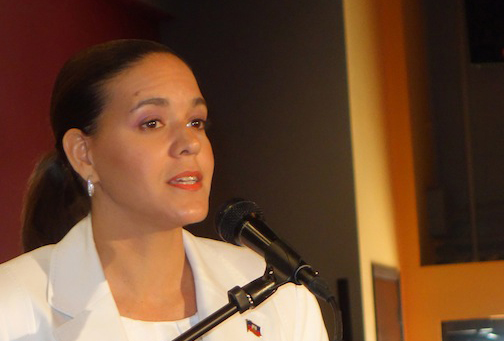Above: Haiti Communication Minister Regine Godefroy (CJ Photo)
By Alexander Britell
MIAMI — At a forum at Harvard University’s Kennedy School of Government Tuesday night, actor and Haiti Goodwill Ambassador Sean Penn mentioned the sometimes problematic way in which Haiti is portrayed by the international media.
“There is, in American journalism, a very titillating marriage between those who report on struggle, and their demand that struggle remain present for them to report on,” he told the forum in Cambridge, Mass.
Penn was speaking primarily about the manner in which the US media in particular had wrote of the way cholera had come to Haiti.
But Penn’s remarks illustrated a larger point — that the way Haiti is covered internationally is often inconsistent, and frequently incomplete.
It mirrors observation by First Lady Sophia Martelly, who told Caribbean Journal in an interview last year that people “need to stop selling our misery.”
Now, Regine Godefroy, Haiti’s new Minister of Communication, is trying to change that.
The plan by Godefroy, who succeeded former Minister Ady Jean Gardy in a Cabinet reshuffle in late January, is to help coordinate Haiti’s government ministries to better communicate just what it is the government is doing on a day-to-day basis, both to the Haitian media and the press abroad.
“The whole government is doing a lot of work, all of the Ministers are doing a lot of work, but they seem like isolated events,” she told Caribbean Journal. “Our purpose is to collect all the data and rebroadcast it so the population in Haiti and in the United States knows exactly what’s going on, whatever the action is.”
Over the years, the workings of Haiti’s government have remained something of a mystery to outsiders.
“I think there’s been a very big [information] deficit, but that was mostly due to incoherent transmission of the information,” she said. “So what we’re doing now is gathering all the information, making it coherent and sending it out.”
But is a strengthened communications push simply a new form of spin? It’s a charge Godefroy rejects.
“It’s going to be telling people that this is exactly what is going on,” she said. “It’s not going to be a propaganda approach.”
Francois Guillaume, Haiti’s Consul General in Miami, echoed that.
“The strategy is to give as much information as possible,” he said. “It’s not tainted information, it’s not “spun” information, it’s pure facts.”
Haiti, as a relatively small country but one with a large amount of media coverage, is “very sensitive” of its perception abroad, he told Caribbean Journal.
“Every time a news outlet writes something that is not totally accurate, it really affects us,” he said. “That’s one of the reasons why we want to give as much information as possible, so people are not inclined to misinform.”
The power of the news media’s role in shaping the discourse about Haiti was the subject of recent research by University of Connecticut Professor Thomas Craemer, who found that the international press was sometimes “drawing an exaggerated picture” of problems in the country.
But Godefroy said she was confident that the international media was “aware and conscious” that Haiti was working to change its image.
Just how effective it will be remains to be seen – but for Godefroy, the way Haiti is perceived has to shift.
The issue, it seems, is not about glossing over serious problems like tent camps and cholera, but about providing a balanced picture of the workings of the country and its leadership.
“We’re very confident that [the international media] is going to understand that they’re participating in Haiti’s growth and Haiti’s development,” she said. “There needs to be balance in the information. We accept criticism, and the government accepts criticism, and we want to work from criticism and go towards the better — but we don’t want to stay in the criticism — we want to promote the good, because there is a lot of good going on.”
